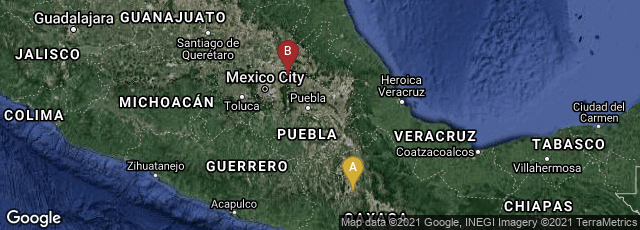

A: Magdalena Jaltepec, Oaxaca, Mexico, B: Zona Industrial, Jaltepec, Estado de México, Mexico
The Codex Selden, also called the Codex Añute, a Mixtec screenfold manuscript preserved in the Bodleian Library (MS Arch. Selden A.2), was acquired by the Bodleian in the 17th century from the estate of jurist, legal antiquary and orientalist John Selden. It is one of less than twenty precolonial Mesoamerican codices that survived the conquest of the Americas, containing information on the history of ancient cities, prescriptions on rituals and calendrical divination. Of those codices, the Codex Selden/Añute is the only palimpsest, as its currently viewable content was written on a white paint layer that covers an earlier pictographic document. The overtext is viewable in a digital facsimile provided by the Bodleian at this link.
In 2013-2014 the Bodleian's Ancient Mexican Manuscripts project undertook the recovery of these hidden pictorial texts. Results were expected to be published in the summer of 2016:
"The use of exclusively organic paints to create these images presented a unique set of challenges necessitating the development of a new imaging technique. During the present intervention this new technique called Photothermal Tomography is combined with a number of other techniques such as high-resolution photography, infrared photography, and RTI imaging to gain a better insight into this important palimpsest"
In August 2016 the Oxford Mail reported the following:
" "After four or five years of trying different techniques, we’ve been able to reveal an abundance of images without damaging this extremely vulnerable item,' said Ludo Snijders from Leiden University, who conducted the research with David Howell from the Bodleian Libraries and Tim Zaman from the University of Delft.,,,
"Mr Snijders said: 'What’s interesting is that the text we’ve found doesn’t match that of other early Mixtec manuscripts. The genealogy we see appears to be unique, which means it may prove invaluable for the interpretation of archaeological remains from southern Mexico.'
"Some pages feature more than 20 characters sitting or standing in the same direction. Similar scenes have been found on other Mixtec manuscripts, representing a King and his council.
"The researchers analysed seven pages of the codex for this study and revealed other images including people walking with sticks and spears, women with red hair or headdresses and place signs containing the glyphs for rivers.
"The paints used to crate the vibrant images are organic and do not absorb X-rays, meaning traditional methods could not be used in trying to get a glimpse of the codex's fascinating stories.
"Working with the humanities division in the University of Oxford, the Bodleian acquired a hyperspectral scanner in 2014 with the support of the university’s Fell Fund – and the equipment was able to unmask the past.
"David Howell, head of heritage science at the Bodleian Libraries, said: 'This is very much a new technique, and we’ve learned valuable lessons about how to use hyperspectral imaging in the future both for this very fragile manuscript and for countless others like it.'
Researchers are continuing to analyse the remainder of the document with the aim of reconstructing the entire hidden imagery, allowing the text to be interpreted more fully.
The Codex Selden/Añute was first published by Edward King, Viscount Kingsborough in his ten volume series, Antiquities of Mexico (1831-1848).
Regarding the history of the codex I quote from John Pohl's Mesoamerica:
"John Selden died in 1654 but the last date associated with the genealogy in the manuscript is the Mixtec year 11 Flint which corresponds to A.D. 1556. A date on the cover of the manuscript (2 Flint) may correspond to 1560 (M.E. Smith 1994:122-123). How the codex got from the Mixteca-Alta, Oaxaca, into the hands of Selden remains a mystery. Smith thinks that Codex Selden was composed by the community of Jaltepec, located in the southern Nochixtlán Valley for presentation to Spanish and Indian authorities with regard to a dispute over a subject town.
The town in question was called Zahuatlán and it is represented in the codex as a hill sign qualified by a man dancing - to signify Zahuatlán’s Mixtec name "yucu nicata" or "Hill that Danced". Both Jaltepec and Yanhuitlán, a principal rival in the the northern Nochixtlán Valley, claimed the town. Lords and Ladies of Zahuatlán appear in the codex either paying homage, intermarrying, or being subjugated by Jaltepec. Since the painting of the codex was assuredly commissioned by Jaltepec, a better name for the manuscript is Codex Añute, Jaltepec’s Mixtec name."